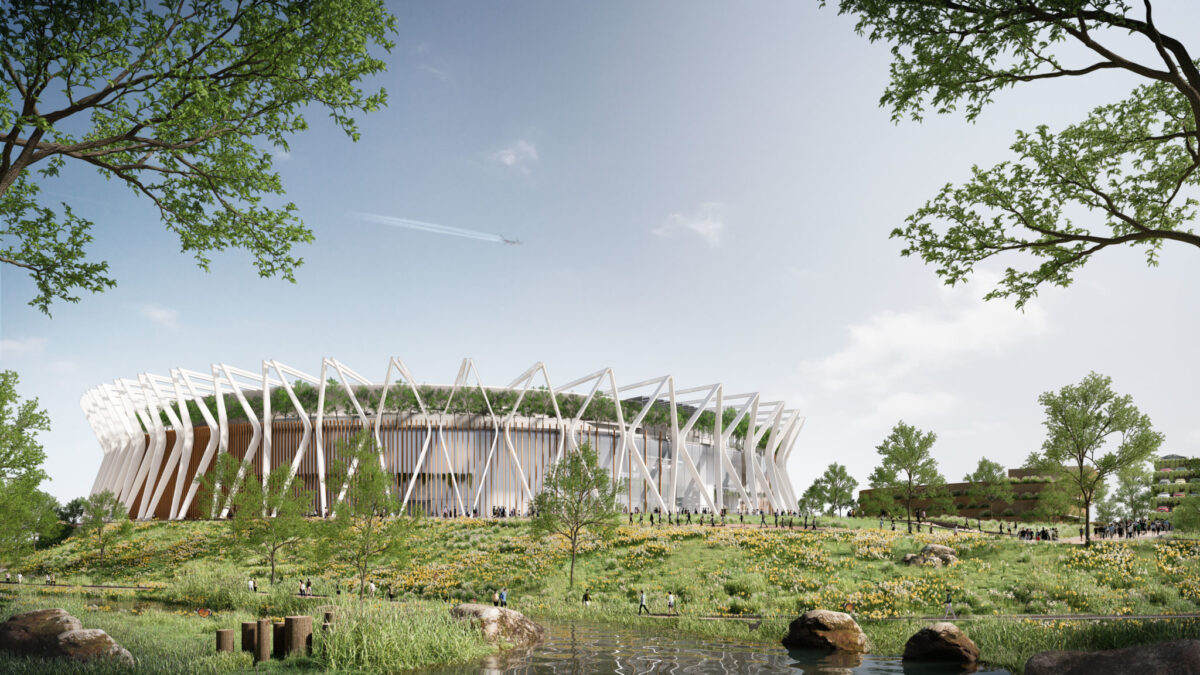News

April 21, 2023

In an age where sustainability is a core tenet and aspiration of society, it is a principal that underpins all of Populous work, and is fundamental to the evolution of the practice. Mohit Mehta is the Populous Global Head of Sustainability, a new role working alongside regional sustainability leads to ensure environmentally sustainable design (ESD) is further embedded across the company’s portfolio. Charlie Brooks, Populous’ Global Director of Communications, caught up with Mohit as he develops his strategy for driving sustainable design within the organization.
Q: Mohit, tell us about yourself and your new role.
A: Sustainability isn’t just one person’s role at Populous, it lies at the heart of everything we do. I joined Populous from ME Engineers, where I held the role of Principal and Building Performance Director. My role at Populous is to lead our overall sustainable vision and strategy, ensuring the enhancement and quality of sustainable design in all our projects. I studied as an architect, practiced as an architect and in engineering, and have extensive background and experience in delivering sustainable design. Now I can use that industrywide knowledge to further develop the sustainability roadmap within practice.
Q: What are the factors driving sustainability as a priority?
A: Simply put, buildings account for approximately 30% of global energy consumption. Through direct use of fossil fuels and fossil fuel-produced electricity, buildings have a substantial impact on our environment and long-term resource availability. Beyond environmental impact, buildings are a focal point for emerging crises related to environmental justice, affordability, health, disaster risks, and water shortages.
Q: What are the key ways architects and designers can influence sustainability in the built environment?
A: Our ultimate goal is for every building to be as sustainable as possible. To achieve this there are 17 U.N. Sustainable Development Goals to incorporate, as well as adherence to the 2015 Paris Agreement. Practically, this may not be achievable in every instance (yet). That said, it is crucial to integrate measurable sustainability principles into the design process from the very start of a project: clear sustainability targets that identify specific metrics such as carbon emissions reduction, waste reduction and energy efficiency should be collectively agreed upon and communicated to all stakeholders.
Early-stage planning must include the selection of a sustainable site, as well as consideration of designing for energy efficiency, specifying low embodied carbon materials, conserving water, engaging with the community, and using life cycle analysis (LCA) for informed decision making.
And of course, sustainability is more than environmental — for example designing for inclusion, equity and accessibility. There are also targets around public transport and supporting environmental, social and economic links between urban, peri-urban and rural areas.
Q: How can we better reduce waste in the construction of public assembly venues?
A: In terms of building design, Populous was instrumental in designing Climate Pledge Arena in Seattle, Washington, which began with an epic concept of recycling by putting a 44-million-pound historic roof from the 1962 World’s Fair on stilts, while a new arena was built underneath. The move to save the roof and expand the arena space underground reduced the embodied energy use typical of new construction.
Within building design, upcycling, recycling and repurposing are effective methods of reducing construction waste. Upcycling is an approach we’re employing to great effect in our Stade de La Meinau project in Strasbourg, France, where we will use fuselage sections from decommissioned A430 aircraft to create the sunshade panels for the stadium’s new south stand. This will drastically reduce the embodied carbon emissions associated with manufacturing this aspect of the design.
Additionally, reusing aggregate is another effective approach. When we designed the London Olympic Stadium, 40% of the concrete used in its construction was made from recycled aggregate. For these to be successful, design and construction teams need to develop and implement a comprehensive construction and demolition waste management plan. The use of digital modelling and prefabrication can also help reduce waste.
Commbank Stadium in Parramatta, Australia, was the first stadium in the world to announce it had received LEED v4 Gold certification, and the first building in Australia to receive the certification. More than 90% of the materials from the old Parramatta Stadium were diverted from landfill by recycling them to construct the new stadium, and more than 700 kilograms of soft plastics from new seat covers were recycled, contributing to asphalt for roads and plastic wheel-stops.
Q: How can we avoid ‘greenwashing’ in stadium/arena design projects?
A: Avoiding greenwashing in design processes is important and requires a commitment to transparency and accountability. There are many nuances, however, and must be understood when achieving certification at the highest levels using environmental assessments tools like LEED, BREEAM, Green Star, GSAS, and/or IFLI Zero Carbon is vital. These assessments are critical in holding architects and projects to internationally recognized standards and best practices. Even more important is that architects and their clients — be they sports clubs or governing bodies — are authentic in their commitment to delivering sustainable projects.
Organizations must take practical and measurable steps — it must be about action, not only words. That’s why we’re committed to implementing science-based targeted strategies across all our projects. We have also pledged to comply with the AIA 2030 Commitment in North America and Architects Declare in the UK and Australia. Architects Declare is a network of architectural practices committed to addressing the climate and biodiversity emergency. The AIA 2030 Commitment is an actionable climate strategy that outlines standards and goals for reaching net zero emissions in the built environment and uses energy use index (EUI) as the tracking metric.
Q: What are considerations around renovating existing facilities, versus designing a new venue entirely?
A: Repurposing existing facilities not only preserves the embodied energy in the existing structure but also reduces the carbon footprint associated with the construction of new buildings. Repurposing an existing building can also help conserve natural resources by minimizing the need for new construction materials. This can include reusing existing materials, salvaging materials from other buildings, and incorporating recycled materials into the project.
Of course, when we look at sustainability in a holistic manner, as much as it’s about reducing carbon emissions and energy consumption, it’s also about the long-term viability and social value of a project. In the case of stadiums and arenas, a venue that hosts a single game or event once every two weeks and lies dormant in between is not sustainable. Modern, sustainable venues are multipurpose destinations that draw visitors throughout the week and year-round. In some instances, it may be the case that a renovation project won’t deliver this flexibility, and it’s in these cases that a new build option should be considered.
Q: If the aim is to be sustainable, do smaller and refurbished venues have a commercial advantage over big flagship venues?
A: When it comes to the commercial advantage of smaller and refurbished venues versus bigger flagship venues in terms of sustainability, the answer can vary depending on several factors. One approach that can provide both sustainability and commercial benefits is the concept of multipurpose venues. This approach allows for greater flexibility and utilization of the space, making the project more financially viable and sustainable in the long run.
Multipurpose venues can also reduce the need for new construction and promote the adaptive reuse of existing structures, which can reduce the environmental impact and cost associated with new construction. Ultimately, if the planning and design have been approached correctly, with a view to embedding the venue into the community and providing a meaningful legacy, then large-scale venues should be at no disadvantage in this regard.
Q: How do sustainability and flexibility coexist in design?
A: These two design factors are often complementary. Flexibility is a hugely important component of sustainable venue design and one that is often overlooked, particularly in the case of stadiums. People like to say that stadiums are modern-day cathedrals, but they are more like town halls — versatile destinations that should bring socioeconomic value to communities. In this sense, sustainability and flexibility must coexist for a project to be successful.
Our design for the Tottenham Hotspur Stadium is a good example of flexible design — the stadium includes a fully retractable grass pitch for football with an artificial playing surface beneath that is used for NFL games and other events such as concerts.
Flexible stadiums clearly require being proactive and planning ahead, but the long-term savings in time, money and materials make it a very reasonable investment. Due to the nature and size of these projects, all stadiums have a significant embodied carbon footprint. Flexible venues provide another benefit: long-term sustainability. If a space can be adapted rather than destroyed and/or rebuilt, clearly that is better for the environment, as well as the bottom line.
In essence, sustainability and flexibility both require a focus on resilience. A sustainable venue that is designed to be resilient is also inherently flexible, adapting over time to meet evolving needs.
Q: Could a move away from traditional methods of construction to modular construction for new developments support sustainability?
A: Modular construction can reduce the carbon footprint of construction by helping to reduce the energy consumption and waste associated with manufacturing (since the components are mass produced), and the transportation of the prefabricated modules can be executed more efficiently, reducing emissions associated with construction transportation.
It’s an approach that we’ve explored with our projects for some time now, going back to the London 2012 Olympic Stadium. Before the Games, there was a question over the long-term future of the stadium, and it was clear there would be no use for an 80,000-capacity venue, so we designed it to be a modular construction so that entire pieces could be lifted away without affecting other components. This allowed the capacity of the venue to be scaled back as necessary. We are now working with the London Stadium on installing a solar membrane on the roof to reduce carbon emissions.
Modular construction can be sustainable by promoting energy efficiency, reducing waste and carbon footprint, improving air quality during the relatively quicker construction process, and by using low emitting materials (paints, adhesives, insulation materials, etc.).
Q: Could conversion of demountable solutions into semipermanent structures help increase sustainability?
A: The key is to build flexibility into the design from the outset, or else the additional work involved in conversion projects can prove costly in terms of the outlay in carbon emissions.
Semipermanent structures can be easily modified to meet changing requirements, making them more adaptable and reducing the need for new construction. This approach can also help reduce waste generation: instead of discarding the demountable structures after a single use, the structure is modified and reused, reducing the need for new construction and further reducing waste generation, as well as the carbon footprint from construction.
Lorem ipsum dolor sit amet consectetur, adipisicing elit. Non facere corporis et expedita sit nam amet aut necessitatibus at dolore enim quis impedit eius libero, harum tempore laboriosam dolor cumque.
Lorem, ipsum dolor sit amet consectetur adipisicing elit. Illo temporibus vero veritatis eveniet, placeat dolorem sunt at provident tenetur omnis, dicta exercitationem. Expedita quod aspernatur molestias eum? Totam, incidunt quos.